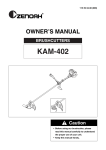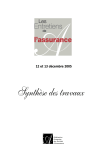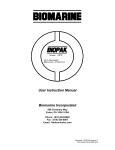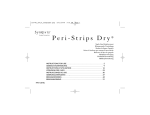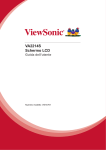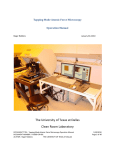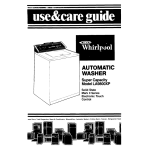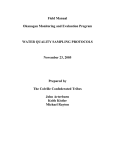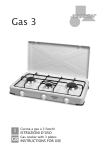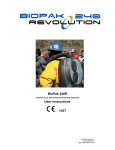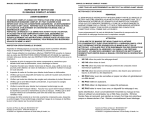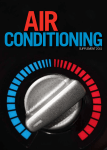Download Biopak 240S User Instruction Manual Biomarine Incorporated
Transcript
Biopak 240S User Instruction Manual Biomarine Incorporated 456 Creamery Way Exton, PA 19341 USA Phone: (610) 524-8800 Fax: (610) 524-8807 Web: www.NeutronicsInc.com Email: [email protected] Document: A46D029 Revision: F, ECO 7509 Part Number: B5-06-6240-00-0 A46D029 Biopak 240 S User Manual Part Number B5-06-6240-00-0 Revision F ECO 7509 Table of Contents Subject Page I. NIOSH Approval Label 3 II. Cautions and Limitations 4 III. S. Special or Critical User’s Instructions 4 IV. Preparing for Use 6 V. Operation Instructions 9 VI. Post-Use Instructions 12 VII. Benchman’s Training Manual 12 VIII. Warranty Statement 13 -2- 240-MIN/3000 PSIG/SC/PD Alternate Alternate Alternate Alternate Carbon Alternate Carbon Coolant Oxygen Carbon Connection Inhalation Exhalation Lower Center Dioxide Upper Pneumatic Coolant Dioxide Canister Cylinder Dioxide Breathing Breathing Breathing Housing Housing Assembly Section Scrubber Device Scrubber Assembly Assembly Absorbent Hose Hose Hose Assembly Assembly Assembly Lid Assembly Assembly D46A019-02 D46A019-01 D46A018 LimePak B17A013 C17A003-04 GelPak D46A014 GelTube D17A038 D46A010 Factory Packed 300-887 G2 Standard 300-887 G1 without Anti-Anoxia D46A006-02 with Anti-Anoxia D46A006-01 D46A007 with Rotational Latch with Draw Latch D46A008-02 D46A008-01 with Rotational Latch D46A009-02 with Draw Latch D46A009-01 -3- X X X X X X X X X [ECO 6706] [REV E] 06/28/01 X JMNOS Cautions Antiand Fog Agent Limitations2 Biopak 240 S User Manual Part Number B5-06-6240-00-0 2. CAUTIONS AND LIMITATIONS J-Failure to properly use and maintain this product could result in injury or death. M-All approved respirators shall be selected, fitted, used and maintained in accordance with MSHA, OSHA and other applicable regulations. N-Never substitue, modify, add or omit parts. Use only exact replacement parts in the configuration as specified by the manufacturer. O-Refer to User;s instructions, and/or maintenance manuals for information on use and maintainance of these respirators. S-Special or critical User's Instructions and/or specific use limitations apply. Refer to User's instructions before donning. SC-Self-contained D46A019-03 X D46A011-01 X D45A011-02 Scott-Style, Standard-Small X D45A011-03 Scott-Style, Standard-Large X D45A011-04 Scott-Style, Standard-Xlarge X D45A011-05 Scott-Style, Wipered-Small X Scott-Style, Wipered-Large X 400-471 G2 X D46A011-06 X Scott-Style, Wipered-Xlarge X 400-471 G11 X AGA-Style, Microphone X AGA-Style, Speaking Diaphragm X 400-471 G12 X 400-471 G13 AGA-Style, Voice Amplifier X AGA-Style, Wipered X D42A021 X B46D060 Drager-Style X Eyeglass Kit X B46D061 X B17D190 Voice Amplifier X Accessories Cylinder Knob Extender X Alternate Facepiece Assembly 201-228 G1 1. PROTECTION PD-Presure demand 13F-466 PROTECTION1 EMAIL: NeutronicsInc.com RESPIRATOR COMPONENTS THESE RESPIRATORS ARE APPROVED IN THE FOLLOWING CONFIGURATIONS: TC# Biopak 240S FAX: (610) 524-8807 CLOSED-CIRCUIT, PRESSURE DEMAND, ENTRY AND ESCAPE, SELF-CONTAINED BREATHING APPARATUS PHONE: (610) 524-8800 BIOMARINE INCORPORATED 456 CREAMERY WAY, EXTON, PA 19341-2532 USA A46D029 Revision F ECO 7509 A46D029 Biopak 240 S User Manual Part Number B5-06-6240-00-0 Revision F ECO 7509 II. Cautions and Limitations ♦ Failure to properly use and maintain this product could result in injury or death. ♦ All approved respirators shall be selected, fitted and maintained in accordance with MSHA, OSHA, and other applicable regulations. ♦ Never substitute, modify, add or omit parts. Use only exact replacement parts in the configuration as specified by the manufacturer. ♦ Refer to User’s Instruction, and/or maintenance manuals, for information on use and maintenance of these respirators. ♦ Special or critical User’s Instructions and/or specific use limitations apply. Refer to User’s Instructions before donning. III. S. Special or Critical User’s Instructions ♦ All users of the Self-Contained Breathing Apparatus (SCBA) must be trained by qualified instructors in donning, operation, inspection and emergency use procedures. ♦ All repairs beyond the scope of this manual must be performed by Biomarine Incorporated. ♦ Prior to using the SCBA it must be determined that user is medically fit. The following are some, but not all, medical and psychological conditions that could limit the use of the SCBA: ¾ Emphysema ¾ Chronic Obstructive Pulmonary Disease ¾ Bronchial Asthma ¾ X-ray evidence of Pneumonia ¾ Evidence of reduce pulmonary function ¾ Coronary Artery Disease ¾ Severe or progressive hypertension ¾ Epilepsy-Grand Mal or Petit Mal ¾ Pernicious Anemia ¾ Diabetes-Insidious or Mellitus ¾ Breathing difficulties when wearing a SCBA ¾ Claustrophobia or anxiety when wearing a SCBA ¾ Abnormal or ruptured ear drum ♦ Compressed Oxygen Hazard: Always handle oxygen cylinders with care to prevent rupture. Do not allow oil, grease or other combustible materials to come in contact with the cylinder or cylinder valve to prevent ignition. Do not open the cylinder valve in the presence of open flame or sparks to prevent ignition. Failure to heed this warning may result in personal injury or death due to sudden release of high pressure oxygen and/or fire. ♦ Oxidizing Agent Hazard: Oxygen is a non-flammable gas; however, it will enhance the combustion of other materials. Oxygen enrichment will decrease the energy required for the ignition of materials. In an oxygen rich environment, oxygen concentration exceeding 23% by volume at sea level, materials that normally will not burn in air may burn; and, materials that do burn in air will burn more vigorously and at a higher temperature. Oxygen will not cause materials to ignite unless there is an ignition source present. -4- A46D029 Biopak 240 S User Manual Part Number B5-06-6240-00-0 Revision F ECO 7509 This SCBA is approved for respiratory protection during entry into and escape from oxygen deficient atmospheric gases and vapors at temperatures above +15oF. ♦ This SCBA is approved only when the oxygen cylinder is fully charged with compressed oxygen meeting U.S.P. specifications. ♦ The oxygen cylinder shall meet applicable DOT specifications and shall be marked “COMPRESSED BREATHING OXYGEN”. ♦ Do not use this apparatus near open flames or in high radiant heat. ♦ After each use of this apparatus, a fully charged breathing gas container and a recharge of carbon dioxide absorbent shall be installed. ♦ Thorough cleaning and disinfecting of the facepiece, breathing tube and breathing bag must be done in accordance with the manufacturer’s instruction. ♦ Use with adequate skin protection when worn in gases or vapors that poison by skin absorption (for example hydrocyanic acid gas). ♦ A good facepiece seal is important since facepiece leakage will severely reduce service time. ♦ Use of pure oxygen or enriched air increases the flammability and lowers the ignition temperature of most materials. -5- A46D029 Biopak 240 S User Manual Part Number B5-06-6240-00-0 Revision F ECO 7509 IV. Preparing for Use 1. Inspect the Turn-Around Maintenance Tag that should be hanging from the oxygen cylinder valve handle. Verify that the tag is valid and less than one (1) year has elapsed from its completion date. The Turn-Around Maintenance Tag will assure that the Biopak has undergone the full Turn-Around Maintenance to enable reuse as listed below. • Carbon Dioxide scrubber has been recharged with absorbent and reinstalled into the center section. • Oxygen cylinder has been properly charged and installed. • Biopak has been flow tested. • Alarm whistle function has been tested. • Facepiece lens has been coated with anti-fog agent. WARNING: DO NOT use any Biopak that has a missing Turn-Around Maintenance Tag or that has a Turn-Around Maintenance Tag dated one (1) year prior to the date of intended use. A missing tag will require that the Biopak undergo the full Turn-Around Maintenance Procedure before it can be utilized. Tags in excess of one (1) year will require the replacement of the carbon dioxide absorbent material before the Biopak can be utilized. 2. Remove the upper housing from the Biopak by disconnecting the two latches located on the bottom of the housing and swinging and lifting the housing off the hinge plates of the lower housing. 3. Inspect all connections for tightness and verify that the breathing hoses exiting the housing are connected together with the hose coupler fitting. 4. Verify that the oxygen cylinder pressure gauge reads between 2700 and 3000 psig. WARNING: If the oxygen cylinder pressure gauge does not read between 2700 and 3000 psig then the Biopak can not be utilized for the full four-hour duration. 5. Obtain a frozen coolant canister charge and install it into the coolant canister as outlined below. a) Release the coolant canister from the lower housing by disconnecting to the two canister straps. b) Lift the capped end of the canister up and remove the end cap by rotating to its full clockwise position. c) Slide the frozen charge into the canister so that it is fully seated within the assembly. d) Install the end cap back onto the canister and secure by rotating it to its full counterclockwise position to engage the locking pins. e) Reposition the canister into the lower housing and secure with the two straps. -6- A46D029 Biopak 240 S User Manual Part Number B5-06-6240-00-0 Revision F ECO 7509 6. Coat the inside of the facepiece lens with the anti-fog agent. The agent shall be applied with a soft, clean cloth and buffed until it can be seen through. Note that excessive buffing may diminish the effectiveness of the agent. Facepieces that contain the wiper feature should have the anti-fog agent applied to the lens as well as soaking the wiper blade with the solution prior to use. 7. Replace the upper housing onto the lower housing and latch to secure in position. 8. Don the Biopak as outlined below. a) Place the Biopak onto the shoulders by slipping arms through the shoulder harness. b) Lean forward slightly and tighten the shoulder straps by pulling down and away from the body while returning to an erect posture. c) Buckle and adjust the waist strap firmly on the hips. d) Loosen the shoulder straps to allow the weight of the Biopak to rest on the hips and not the shoulders. e) Connect and adjust the chest strap. Do not over tighten the strap to the point of constriction. 9. Don the facepiece as outlined below. a) Loosen the facepiece harness straps. b) Place the facepiece harness over the head. If necessary, smooth the top of the harness against the scalp with hand. c) Center chin comfortably in the facepiece chin cup. d) Holding the facepiece against the face with one hand, tighten the bottom straps evenly with the other hand. e) Tighten the upper straps evenly by pulling gently and simultaneously. Note: Do not over tight the facepiece against the face. This can cause discomfort during use and may lead to facepiece seal leakage. CAUTION: A poor facepiece seal will cause a significant decrease in Biopak duration and protection factors. Beards or eyeglasses that cause seal failure are in violation of OSHA and MSHA regulations and will void the NIOSH approval of the Biopak. 10. Perform a negative pressure check on the facepiece as outlined below. a) Block the inhalation port, green port, of the facepiece with the palm. b) Attempt to inhale. The mask should collapse onto the face and inhalation should be impossible if the fit is good. c) If leaks are evident or it is possible to inhale then refit the facepiece or inspect the facepiece inhalation check valve for leakage. 11. Perform a positive pressure check on the facepiece as outline below. a) Block the exhalation port, red port, of the facepiece with the palm. b) Attempt to exhale. If the facepiece begins to push away from the face then the fit is good. c) If leaks are evident and the facepiece does not push away then refit the facepiece or inspect the exhalation check valve for leakage. -7- A46D029 Biopak 240 S User Manual Part Number B5-06-6240-00-0 Revision F ECO 7509 12. Connect the facepiece to the Biopak breathing hoses by removing the hose coupler fitting between the hoses and connecting the green coded hose to the green coded facepiece port; and, the red coded hose to the red coded facepiece port. 13. Reach back and open the oxygen cylinder valve by turning it to its full counterclockwise position and back ¼ turn. The alarm whistle should provide a brief “chirp” signaling that it is now armed. WARNING: If no “chirp” is heard when the oxygen cylinder is opened the alarm valve may not have armed and may not function correctly. Do not use the Biopak if the alarm whistle does not “chirp” when the oxygen cylinder is opened. 14. Verify that the pressure gauge located on the chest of the Biopak harness reads between 2700 and 3000 psig. It is normal for the pressure gauge of the harness to take up to 90 seconds to come to a full reading due a protective flow restrictor located in the pressure line. 15. Reach back and tear away the Turn-Around Maintenance Tag from the handle of the oxygen cylinder and discard. 16. The Biopak is now ready for use. -8- A46D029 Biopak 240 S User Manual Part Number B5-06-6240-00-0 Revision F ECO 7509 V. Operation Instructions 1. Normal Breathing: The user shall breath normally as if the Biopak was not in place. The Biopak will follow the pace and demands of the user. When additional volumes of breathing gas are required the Biopak will automatically add additional oxygen. When excessive breathing volumes are present the Biopak will automatically vent the excess volume. The user must be familiar with the conditions that occur while using the Biopak. Depending upon the level of activity of the user and the surrounding ambient temperature, the breathing gas being delivered to the user will be warmer and more humid than conventional open-circuit devices. Delivered breathable atmospheres will be in the 90-100% oxygen and relative humidity range. The moist breathing gas will prevent the drying of user mucous membranes and also prevent sore throats that are often a side effect of utilizing respiratory devices. 2. Facepiece Speaking Diaphragm: The standard facepiece is fitted with two speaking diaphragms, one located on each cheek. The speaking diaphragms will aid in the transmission of the user’s voice through the facepiece to the external location. When speaking it will benefit the function of the speaking diaphragm if speaking tones are slightly louder than normal, no attempts are made to shout, words are enunciated clearly and speaking is slow. Optional communication devices are available that utilize microphones or voice amplification modules. These devices will be supplied to the user with their own instructions for use. 3. Emergency Bypass Valve: In the event the user feels that additional oxygen is required above that supplied by the normal operation of the Biopak, the bypass valve may be depressed at any time to admit additional oxygen into the breathing loop. The valve is located beneath the oxygen cylinder valve and is color coded red. The valve shall be depressed for 2 second intervals and should only be utilized in an emergency situation. CAUTION: Use of the bypass valve should only be during an emergency situation as repeated use will severely decrease the duration of the Biopak. The bypass valve will not aid in clearing the facepiece lens and will only result in loss of oxygen supply and decrease of Biopak duration. 4. Chest Mounted Pressure Gauge: The chest mounted pressure gauge is attached to the shoulder of the harness assembly via velcro; and, will provide the user with a direct read out of oxygen supply. A protective flow restrictor is located in the plumbing to protect against sudden loss of oxygen should the gauge line become severed during use. The gauge will provide an approximate indication of remaining service life as listed below. In all cases, the user should immediately exit the contaminated area whenever the pressure gauge indication is the red area of the gauge dial. Approximate Service Life Chart for Chest Mounted Pressure Gauge Indications Gauge Reading, psig 3000 2250 1500 750 Remaining Service Life, hours 4 3 2 1 -9- A46D029 Biopak 240 S User Manual Part Number B5-06-6240-00-0 Revision F ECO 7509 5. Alarm Whistle: When the service life of the Biopak has dropped to approximately 1hour (600-750 psig) the alarm whistle will provide a 92dB tone for 45-60 seconds to alert the user to exit the contaminated area. Whenever the alarm whistle sounds, the user must consider escape routes out of the contaminated area that can be accomplished under 1-hour. The whistle extends through the lower housing above the oxygen cylinder valve. When the alarm sounds, the user can reach back and block the whistle extension and listen for a change in tone to verify that the alarm is sounding. WARNING: The alarm whistle provides a one-time 45-60 second indication of 1hour service time remaining. The entire work crew should prepare to terminate work allowing sufficient time to the exit the contaminated area as soon as the alarm has sounded. 6. Emergency Operation: Situations may arise during use of the Biopak that warrant special attention as described below. a) Equipment Failure (such as a blocked line or breathing hose): If breathing becomes difficult, try utilizing the bypass valve. Immediately exit the contaminated area and secure a different Biopak. b) Severed Chest Mounted Pressure Gauge Line: The pressure gauge is protected by a flow restrictor that will prevent the sudden loss of oxygen supplies in the event the pressure line becomes severed. Immediately exit the contaminated area and secure a different Biopak. c) Excessive Adding of Oxygen During Use: This situation can be identified by continued, audible blasts of gas flow internal to the Biopak. This situation will usually indicate a leak in the facepiece seal or the Biopak itself. Using a Biopak that contains either a leaking facepiece seal or a leaking component will result in the reduction of operation time. Try to adjust the facepiece to stop the leak or immediately exit the contaminated area and secure a different Biopak. d) Regulator Failure: The Biopak regulator is designed to fail in the open condition. While extremely rare, failure may be detected by excessive pressure in the facepiece and excessive venting of the Biopak. A regulator that has failed in the open condition will quickly exhaust the oxygen supply and decrease the duration of the Biopak. Immediately exit the contaminated area using the breathing procedure described below. i. Immediately close the oxygen cylinder valve. ii. Conserve breaths and proceed from the contaminated area in a calm fashion. iii. Briefly open the oxygen cylinder valve on every fifth breath to replenish the supply into the breathing loop. iv. Repeat the above steps until the contaminated area has been exited. WARNING: The emergency breathing procedure for regulator failure stated above will not work properly if the Biopak is fitted with the optional antianoxia valve. - 10 - A46D029 Biopak 240 S User Manual Part Number B5-06-6240-00-0 Revision F ECO 7509 e) User Symptoms and Warning Signs: If at any time during the use of the Biopak the user experiences any of the below listed symptoms the contaminated area should immediately be exited and the user shall seek medical or technical assistance. • Feelings of nausea, dizziness or illness • Rapid pressure drop on chest mounted pressure gauge • Difficulty with inhalation or exhalation • Smoke or other contaminates in the facepiece 7. Biopak Duration Notes: The Biopak is designed to provide four (4) hours of continuous use. The actual duration of use may vary with user size, work load, ambient conditions, etc. It must be noted that the Biopak provides an indication of oxygen supply only and does not provide the user with an indication of remaining carbon dioxide absorbent. Therefore, it is suggested that the user always exit the contaminated area after an elapsed duration of four hours to avoid the dangers of carbon dioxide poisoning. WARNING: The Biopak will provide no indication of remaining carbon dioxide absorbent during use. Therefore it is suggested that the user never utilize the Biopak past the four-hour mark during any single exercise to avoid the dangers of carbon dioxide poisoning. Additionally, NIOSH approvals will be voided if the user attempts to extend the duration of the Biopak by simply exchanging oxygen cylinders without also exchanging the coolant canister charge and the carbon dioxide scrubber charge. - 11 - A46D029 Biopak 240 S User Manual Part Number B5-06-6240-00-0 Revision F ECO 7509 VI. Post-Use Instructions 1. Verify that the contaminated area has been completely exited and that it is safe to remove the Biopak. 2. Close the oxygen cylinder valve by rotating it to its full clockwise position. 3. Remove the facepiece by pushing forward on the lower head harness buckles and lifting the facepiece over the head. 4. Unbuckle the Biopak chest and waist straps while slightly leaning forward. 5. Loosen the Biopak shoulder harness straps. 6. Slide the Biopak off the back and onto a suitable surface. 7. Submit the Biopak and the facepiece to Turn-Around Maintenance. VII. . Benchman’s Training Manual The Benchman’s Training Manual, part number B5-06-6240-01-0, is supplied with every Biopak and will detail Turn-Around Maintenance procedures, Periodic Long-Term Maintenance procedures, service procedures, Biopak theory and factory service. Exploded parts lists are provided in the Benchman’s Training Manual as well. - 12 - A46D029 Biopak 240 S User Manual Part Number B5-06-6240-00-0 Revision F ECO 7509 VIII. Warranty Statement Biomarine warrants, subject to the terms below, that the goods will be free from defects in design, materials, and workmanship for a period of three (3) years from the date that the goods are purchased by buyer, with the exception of rubber components. Rubber and silicone rubber components are similarly warranted for a period of one (1) year from the date of purchase. THIS WARRANTY DOES NOT APPLY TO OXYGEN CYLINDER HYDROSTATIC TESTING FOR PERIODIC RECERTIFICATION OF THE PRESSURE VESSEL. THE SOLE LIABILITY OF BIOMARINE FOR ALL PURPOSES SHALL BE TO REPLACE, AT THE SOLE OPTION OF BIOMAINRE, DEFECTIVE PARTS APPEARING WITHIN THE THREE OR ONE-YEAR PERIOD AS APPLICABLE. BIOMARINE SHALL PROVIDE PARTS AT ITS OWN EXPNSE BUT ALL LABOR SHALL BE AT THE EXPENSE OF THE BUYER. BIOMARINE SHALL HAVE NO OBLIGATION FOR REPLACEMENT UNLESS: 1. BIOMARINE HAS RECEIVED WRITTEN NOTICE OF THE ALLEGED DEFECT WITHIN THIRTY (30) DAYS FOLLOWING THE DISCOVERY OF THE DEFECT OR THIRTEEN (13) MONTHS FROM THE DATE OF PURCHASE, WHICHEVER OCCURS SOONER; AND 2. THE BUYER SUBMITS PROOF OF DATE OF PURCHASE WITH INVOICE OR EQUIVALENT DOCUMENTATION; AND 3. THE DEFECTIVE GOODS ARE PROMPTLY RETURNED BY BUYER, AT THEIR SOLE EXPENSE TO BIOMARINE AT: 456 CREAMERY WAY, EXTON, PA 19341 USA; AND 4. THE EQUIPMENT HAS NOT BEEN ALTERED; AND 5. THE DEFECT OCCURS UNDER CIRCUMSTANCES OF PROPER USE IN ACCORDANCE WITH ALL INSTRUCTIONS AND MANUALS PROVIDED TO THE BUYER. It shall be the responsibility of the buyer to read carefully and abide by all instructions provided to the buyer in the instruction manual or elsewhere. If buyer, and the employees of the buyer, did not abide by such instructions, then the alleged defect shall not be deemed to have arisen under circumstances of proper use. The instructions for use of the goods reflect the opinion of experts based on field use and tests. The instructions should be followed carefully. It is impossible, however, to eliminate all risks inherently associated with the use of the goods. Unintended consequences may result because of factors as weather conditions, the presence of other materials, or the use or manner of application of the goods, all of which are beyond the control of Biomarine. All such risks shall be assumed by the buyer. Buyer shall be responsible for insuring that the goods are functioning properly at all times and shall not use any goods which are not functioning properly. If buyer uses goods when they are not functioning properly, then buyer agrees to defend, indemnify and hold Biomarine harmless against all losses, damages and injuries to persons or property as a result of the use of the malfunctioning goods. These warranties do not extend to the goods if they have been subjected to misuse, neglect or accident, including extended exposure to direct flames and/or caustic chemical products, after its delivery to buyer, nor does it extend to any item that was modified or altered after its delivery to buyer. IN NO EVENT WILL BIOMARINE BE LIABLE FOR ANY LOSS OR DAMAGE DIRECTLY OR INDIRECTLY ARISING FROM THE DEFECTS OR FROM THE USE OF THE GOODS OR FOR CONSEQUENTIAL OR INCIDENTAL DAMAGES, WHETHER IN CONTRACT, TORT, OR OTHERWISE, OR FOR PERSONAL INJURY OR PROPERTY DAMAGE OR ANY FINANCIAL LOSS. Any description of the goods contained in any documents to which these warranty provisions related, including any quotations or purchase orders relating to the goods being delivered to buyer, are for the sole purpose of identifying the goods, and any such description, as well as any sample or model which may have been displayed to or seen by buyer at any time, have not been - 13 - A46D029 Biopak 240 S User Manual Part Number B5-06-6240-00-0 Revision F ECO 7509 made part of the basis of the bargain and have not created or amounted to any warranty, express or implied, that the goods would conform to any such description or any such sample or model. EXCEPT AS SPECIFICALLY SET FORTH IN THESE WARRANTIES, BIOMARINE MAKES NO WARRANTIES, EXPRESS OR IMPLIED, WHETHER ARISING BYLAW, CUSTOM, CONDUCT OR USAGE OF TRADE, INCLUDING WARRANTIES AS TO MERCHANTABILITY, OR AS TO THE FITNESS OF THE GOODS FOR ANY PARTICULAR USE OR PURPOSE, AND ANY WARRNTIES INCLUDING WARRANTIES AS TO MERCHANTABILITY AND FITNESS FOR PARTICULAR USE OR PURPOSE AND THE RIGHTS AND REMEDIES PROVIDED HEREIN ARE EXCLUSIVE. THESE WARANTIES SHALL RUN TO THE BUYER ONLY AND SHALL NOT BE CONSTRUED AS A CONDITION. Biomarine does not warrant that the goods are free from the rightful claim of any third person by way of infringement or patents or other proprietary information or disclaims any warranty against such infringement. The terms of these warranties shall apply to the product sold by Biomarine, except absorbent, filters and anti-fog lens inserts which are considered “consumable item”, and as such are not covered by the terms of these warranties. No waiver, alteration or modification of the terms of these provisions shall be valid unless in writing and signed by an executive officer of Biomarine. These warranties shall not apply to accessories or devices purchased by Biomarine and attached to or made part of the goods except that Biomarine warrants the (I) the installation of such items in the completed product shall so conform to the installation instructions of the manufacturers thereof as not to invalidate such applicable warranties on such items as are obtained by Biomarine from such manufacturers, and (ii) the workmanship incorporated in such installation shall be free from defects. - 14 -















